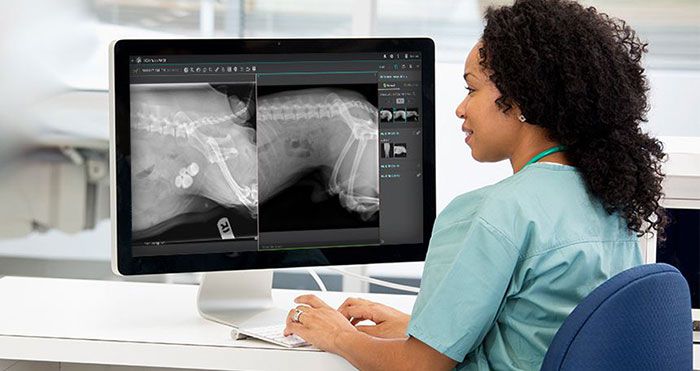How IDEXX Diagnostic Imaging Systems keep veterinary teams safer
Increasing focus on radiation safety in veterinary medicine is challenging practices to find new approaches to x-ray imaging.

Radiation exposure can cause a variety of long-term health consequences, and it is among the top five hazards veterinary teams face.1 There is no established “safe dose,” as even a single radiation exposure has the potential to cause cellular damage. While cells often repair themselves following radiation exposure, some DNA changes go unrepaired, which is why it is widely known that radiation exposure can have health consequences. Your team members are exposed to radiation while taking patient radiographs, which puts them at increased risk for potential side effects of radiation. Since approximately three in four female veterinary technicians are of child-bearing age,2 minimizing radiation exposure is important for your team’s safety.
Your current radiation safety program likely includes using personal protective equipment, a technique chart to minimize retakes, sedation, and positioning devices to maintain reasonable distance between your team and the radiation source. While these practices can significantly reduce your team’s cumulative dose, x-rays scatter in all directions during an exposure, and your team may still be exposed. IDEXX is committed to helping you provide a safer working environment by developing diagnostic imaging systems with your team in mind. The ImageVue DR30, and ImageVue DR50 digital imaging systems produce unmatched diagnostic image quality with lower doses of radiation,3 which may result in decreased patient exposure, subsequent decreased scatter radiation, and ultimately, decreased staff exposure.
Here are six ways IDEXX diagnostic imaging systems help keep your team safer.
#1: IDEXX diagnostic imaging systems use lower doses of radiation to achieve high-quality images
While developing the ImageVue systems, IDEXX engineers considered the need for clear, diagnostic images, as well as user safety. Using the “as low as reasonably achievable (ALARA)” principle, they determined the minimum amount of radiation that would produce sharp, clear images so users would not be exposed to excess radiation. With patented Irradiated Side Sampling (ISS) technology, the ImageVue DR50 system is designed to reduce the radiation dose as much as 10%–20% compared to conventional detectors, and 30%–75% compared to computed radiography (CR), while delivering superior image quality.4
#2: The IDEXX ImageVue DR50 system uses leading-edge technology to produce sharper images with the lowest radiation in veterinary medicine
The ImageVue DR50 system uses patented ISS technology to maximize the efficiency of the light generated during exposure. In typical flat-panel detectors, light travels through a layer of crystals, which convert the captured x-rays to visible light spectrum, before hitting the bottom of the panel, and then creating an image. ISS technology directs the light to the top of the panel, which means the light travels a shorter distance, with less scatter and degradation. This allows a higher-quality image to be produced with the lowest radiation in veterinary medicine.
#3: IDEXX provides a custom technique chart for every diagnostic imaging system
Each imaging system has slight variations that make it different from even others of the same type, which means that different technique settings are required to produce just the right amount of radiation for each exposure. This also means that a generic technique chart cannot accurately be used with multiple systems. Each IDEXX diagnostic imaging system has a technique chart developed by an IDEXX installer and specifically tailored for the practice’s particular panel and generator to provide the optimal image quality possible at the lowest exposure.
#4: IDEXX diagnostic imaging software is designed to optimize veterinary patient anatomy
IDEXX ClearCapture Dx Image Processing Software is unique in that it is designed for the veterinary patient and applies selective algorithms that utilize the lowest dose of radiation for each distinct body part for the optimal image.
#5: IDEXX diagnostic imaging systems minimize exposure time
A typical practice averages 17 two-view image studies per week, which equates to 34 exposures each week.5 Seconds add up, and the longer your team is exposed to radiation week after week, the greater the risk of health problems.6 IDEXX diagnostic imaging systems minimize exposure time to ensure your team’s cumulative dose is as low as possible.
#6: IDEXX provides superior support and training
Only IDEXX provides a dedicated team to help your staff with installation, best practices training, technical support, and refresher training to ensure high-quality radiograph capture with fewer retakes and lower doses. On-site installation, system calibration, and staff training by a team of IDEXX experts will set you up for success from the start. By helping ImageVue system users understand proper technique and positioning, IDEXX can help your team be successful on the first take, which reduces the number of repeat exposures and lowers total radiation exposure. From custom technique charts to thorough user guides, to webinars, to on-demand support, the IDEXX team is here to help your team with any issue that arises.
Are you interested in learning more about keeping your team safer? Let’s talk about the right solution for your practice. Complete this contact form, and one of IDEXX’s team members will reach out to you.
References:
-
Lewis JM. Top five hazards veterinary staffs face. DVM Newsmagazine. Published July 1, 2007. Accessed July 1, 2021. www.dvm360.com/view/top-five-hazards-veterinary-staffs-face
-
NAVTA 2016 Demographic Survey Results. National Association of Veterinary Technicians in America; 2016. www.navta.net/resource/resmgr/docs/2016_demographic_results.pdf. Accessed July 1, 2021.
-
Data on file at IDEXX Laboratories, Inc. Westbrook, Maine USA. Based upon comparison of IDEXX systems to comparable digital imaging systems currently available in the veterinary market.
-
Data on file at IDEXX Laboratories, Inc. Westbrook, Maine USA. Diagnostic Imaging DR and CR Dose Compare.
-
Data on file at IDEXX Laboratories, Inc. Westbrook, Maine USA.
-
Radiation Safety Relating to Veterinary Medicine and Animal Health Technology in California. Sacramento, CA: California Veterinary Medical Board; 2012. www.vmb.ca.gov/forms_pubs/radguide.pdf. Accessed July 22, 2021.